True Stories
Page 39 of 41
 Bruce Roberts 44 - New Rudder
Bruce Roberts 44 - New Rudder
“In my view, the new rudder is a real winner.”
“Ernie the vane has developed a new self confidence that is quite amazing! It’s as if he’s saying ‘OK guys, I’ve got new muscle now, just click my knob, and leave the rest to me…’ “
Roberts 44 in San Francisco and Morro Bay, California, 2007
John, I have waited to write you back in order to accumulate more experience with the new rudder. There were two changes I made to the Hydrovane in Ecuador:
- The new rudder, and
- I made up a 1.25 inch thick teak spacer for the lower vane mounting. This brought the unit into true vertical, whereas before it was “leaning” forward at the bottom.
In my view, the new rudder is a real winner. We are now 6 days and 800 miles out of the Galapagos en route to Fatu Hiva. As well, we used the vane on the 500 mile sail from Ecuador to the Galapagos.
To back up a little, since we left Vancouver, the vane has performed generally well. There were two situations where the boat would occasionally “get away” from the vane: light air downwind sailing, and broad reaching in boisterous conditions. Usually, a little attention to sail balancing would solve the problem. The new rudder seems much more forgiving of boat imbalance. It seems more powerful. It has handled everything to date with aplomb, including the above two problem situations. In fact, Ernie the vane has developed a new self confidence that is quite amazing! It’s as if he’s saying “OK guys, I’ve got new muscle now, just click my knob, and leave the rest to me…”. We know when we turn things over to him, we no longer have to worry about boat control.
To answer your questions:
1. Downwind, light apparent wind: there is not enough power to turn the rudder with the knob on middle setting even with the vane vertical. However, with the knob far left and the vane vertical there is plenty of power- a benefit I think of the new bigger, better balanced rudder.
2. Heavy weather- no problem controlling the boat now. It’s best with the knob in middle setting, and vane inclined about 70%. For example, right now we are broad reaching in 15-18 knots on the port quarter, confused sea, and Ernie is handling it beautifully.
Anyway, it’s a glorious Tradewind day here at 4 43 S, 103 13 W. The sun is out, the SE wind is blowing 15-18, and Madhatter is romping west under genoa & mizzen. Flying fish everywhere. Yesterday we were becalmed and we all went for a swim. Water 27C (remember Pendrell Sound?- same temp). It was eerie, floating there looking down into the deep blue of the abyss. What a neat experience.
We have used our light air gennaker more than we ever thought we would. What a great sail. Many times we would have gone nowhere without it. A last minute purchase by Linda – thank the wind gods she did. Tell everyone at Bluewater to have one on board.
The Galapagos was incredible. Hope to see you guys and tell about it.
Love to all the Currys,
John & Linda
 'Henry the Navigator'
'Henry the Navigator'
“…the wind vane… just kept putting us back on course every time the waves knocked us off.”
“We are sure now that the investment has been worth it.”
It was pretty breezy and Mike wasn’t sure he would be able to set up the Hydrovane properly at first but it was amazing!
Pat certainly couldn’t have handled the tiller in the very rough seas and even Mike would have struggled, but the wind vane (or Henry – the Navigator – as we have named him) just kept putting us back on course every time the waves knocked us off. We are sure now that the investment has been worth it. Everyone we have spoken to has said it’s like having another crew member on board.
From the blog of El Lobo, 39 ft Samson C-Bird Ferro cement junk-rigged schooner built in 1971. She has already been to the Caribbean and the Med and Baltic with her previous owner.
 Malo 39 - ARC
Malo 39 - ARC
“In the Atlantic we rated our Hydrovane as probably the most important bit of kit on board…”
“Without the Hydrovane, we would have been forced to steer by hand, because the autopilot on its own was simply overwhelmed.”
From: nicola & terry
Sent: Thursday, August 16, 2007 9:25 AM
To: John Curry
Subject: Hydrovane replacement vane cover
Hi John
I purchased a Hydrovane for Flinesse, our Malo 39, in the summer of 2004, with the ARC 2006 in mind. We’re now back in the Solent after a trip of 16000 miles which spanned the UK to Greece, the Atlantic ARC crossing, Caribbean cruising from Grenada to the Bahamas, followed by a return to the UK through Bermuda and the Azores on ARC Europe .
The return Atlantic legs were particularly tough because of the recent, continuous unsettled conditions. In the Atlantic we rated our Hydrovane as probably the most important bit of kit on board, especially when having to deal with winds that were above Force 5, often gusting to F8; on the last leg from the Azores to Falmouth we had these conditions the entire time and it would have been nice to have had even one day when the wind was less than 20 kts!
Without the Hydrovane, we would have been forced to steer by hand, because the autopilot on its own was simply overwhelmed. The crew were grateful from ever being forced to leave cover and sit at the wheel exposed to the strong wind and occasional torrential rain, not forgetting the spray, waves and rogue breakers. I was very pleased with the equipment.
I found it could even cope on a dead-run in gusty winds, with a quartering, destabilizing swell, if I used it alongside the electric autopilot. With this configuration, even in these conditions, our fears about an involuntary gybe disappeared. As our voyage was 15 months long, the vane cover suffered from exposure to UV; the bright scarlet faded to pink and the top of the cover split as it is under tension; out in the Atlantic, where the winds were so strong, the vane occasionally flopped onto the ensign jackstaff and eventually it suffered a tear; repair was simple using duck tape! I now need to replace the cover and to match the boat colour scheme, navy would be my preference.
Best wishes Terry
Contact
 John Illingworth 44 Staysail Schooner
John Illingworth 44 Staysail Schooner
“The Hydrovane at a guess has done 20,000 miles now, and still going strong. Close to the land or in tricky conditions it of course requires supervision, but out in a trade wind might not need to be touched for days.”
From: Joe Aston
Sent: Saturday, August 04, 2007 2:36 AM
Hi John,
I attach a couple of photos of ‘Anna M’ setting out on that big cruise. The Hydrovane at a guess has done 20,000 miles now, and still going strong. Close to the land or in tricky conditions it of course requires supervision, but out in a trade wind might not need to be touched for days.
The boat is about 15 tons and maybe it is slightly light for her, especially when the wind is light, but it is invaluable nonetheless. Of course John Illingworth saw to it that she is very well balanced in the first place. The vane works better when the wind is strong. I like the term a Frenchman used for it: ‘un régulateur d’allure’.
I only sail alone when I have to, but have done for example Trinidad/Barbados/ Granada and Isle of Man to here singlehanded. When I have novice guests out, it gives them the chance to get the hang of steering, while in fact myself and the Hydrovane have most of the work in hand!
So good health to yourself and Hydrovane!
Best regards,
Joe Aston
Horseshoe Cottage, Sherkin Island, Co.Cork, Ireland
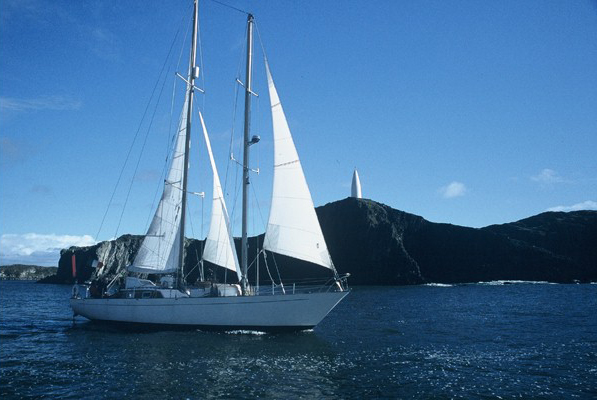
 Westerly Storm 33 - Vane 'Noddy'
Westerly Storm 33 - Vane 'Noddy'
“I have no idea how I’d have coped without it – lots of discussions with interested fellow boaters and I have recommended it without hesitation.”
” ‘Noddy’ as it’s become known, is undoubtedly my most valued piece of kit.”
From: Miles Ashley
Sent: Monday, March 05, 2007 8:49 AM
To: John Curry
Subject: Stormruner- need new pin!
John,
By the way – I am SO pleased I bought this thing – particularly since nobody can seem to get my ST4000 to settle down. It feels like a set of extra wide tyres and the harder it blows it just grips. Astounding.
I’ve done one 600 mile single handed trip round Fastnet and just last week a 500 mile double handed trip in very heavy conditions and I have no idea how I’d have coped without it – lots of discussions with interested fellow boaters and I have recommended it without hesitation.
I’m off to the Azores (www.stormrunner.co.uk ) in June in the AZAB (fundraiser for the Muscular Dystrophy Campaign), and “Noddy” as it’s become known, is undoubtedly my most valued piece of kit.
Regards, Miles Ashley
Contact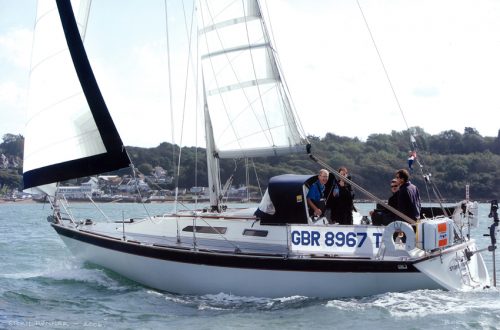
 Najad 373
Najad 373
“The only difficulty was – as you surely remember- that I had to stop the mounting-work because one of the brackets was missing and you had to make preparations for an emergency delivery, The alarm could however be called off, when the bracket was found in the trunk of my car!!”
“Also with “wing to wing” setting with the wind straight from astern the steering was perfect without any unexpected gybes.”
From: Eje Sandberg
Sent: Friday, August 21, 2009 8:19 AM
To: Sherry
Subject: Your homepage
Dear Sherry,
I tried to forward the link of your homepage to a sailing friend of mine but I failed to find it. Have you changed the address? Anyway I would be glad to get it from you. I hope all is well with you and John, Will and the firm.
My Hydrovane is still working fantastico. Last year it steered our Chelonia more than 3000 NM . Round the Orkneys, Scotland, Ireland ,down to Bretagne and home. Absolutely without problems.
Therefore I try to recommend it to everyone who looks on it.
Best regards to all of you.
from Eje
~
From: Eje Sandberg
Sent: Friday, October 06, 2006 3:38 AM
To: John Curry
Subject: Hydrovane on Najad 373
Ulricehamn Oct. 6.. 2006
Hi John,
In June this year we installed your Hydrovane on our CHELONIA, a Najad 373, and we like to give you a brief report. The only difficulty was – as you surely remember- that I had to stop the mounting-work because one of the brackets was missing and you had to make preparations for an emergency delivery, The alarm could however be called off, when the bracket was found in the trunk of my car!!
Again, many, many excuses.
Besides that episode, the installation gave no problem thanks to the clear instructions of the manual. Because of the sloping transom of our boat you recommended use of an H-bracket plus an upper A-bracket, for which I am very glad. The equipment is thereby very stable and sturdy and a fine piece of engineering work. It was offset from the centreline in order not to interfere with the ladder.
There was no time for practical tests in our home-water so the Hydrovane had to start working in real when we set off on our trip from the Swedish West coast across the North Sea to Scotland , the Outer Hebrides and the Orkneys and back. Like many other of your customers we were amazed how simple it was to get the new crew-member to work; (once the sail-setting was in balance). We did appreciated the silence when it was in function and how well it steered; much better than we can. Also with “wing to wing” setting with the wind straight from astern the steering was perfect without any unexpected gybes.
We have not yet had the opportunity to use the new rudder in real nasty weather, but we are confident that it will manage that as well.
We are happy and very satisfied.
both Eje and his son Staffan
Enclosed you will find a photo, which you are free to use as you like.
Contact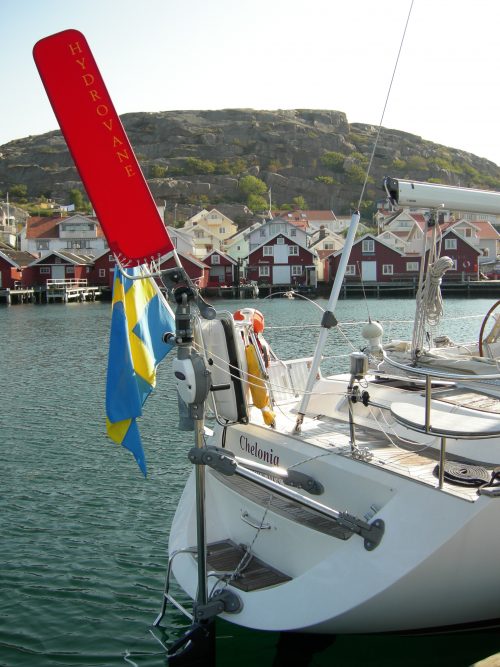
 Westerly Regatta 330
Westerly Regatta 330
“If you ever need support for your recommendation, to mount the vane off centre to preserve fitted boarding ladders, then you are welcome to refer to this.”
“I’ve noticed no performance difference on either port or starboard tacks, even at exceptional angles of heel, despite the vane being 30cm to starboard.”
From: Gavin Blem
Sent: Monday, November 27, 2006 2:31 AM
Subject: Hydrovane Mounting Position
John
If you ever need support for your recommendation, to mount the vane off centre to preserve fitted boarding ladders, then you are welcome to refer to this.
I’ve noticed no performance difference on either port or starboard tacks, even at exceptional angles of heel, despite the vane being 30cm to starboard. Yesterday in a club race on the Medway river in SSW 5 to 6, we had a man overboard at the gybe mark. He fortunately kept hold of the mainsheet as he went over, so he stayed with us and was able to climb aboard as soon as we’d hove to and let go the boarding ladder from its slip knot.
If we’d followed conventional wisdom or other vane designs, the boarding ladder would not have been there and we’d have had a great deal of difficulty getting him on board. We’d also certainly not have retained our position of 2nd out of 19!
Thanks again for your original advice and keep giving it!
Best regards
Gavin Blem
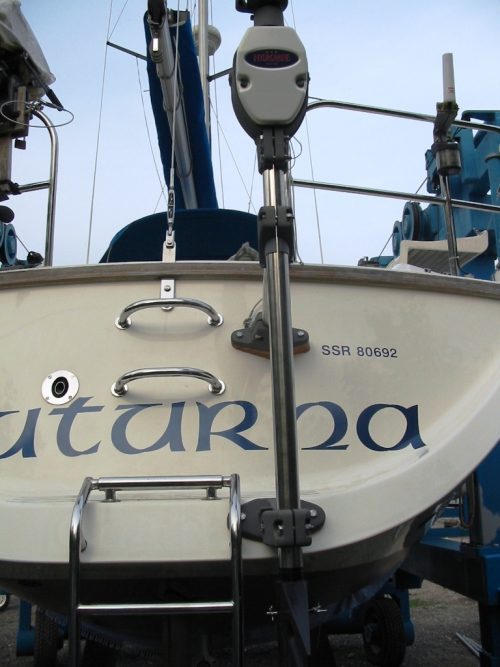
 Prout Snowgoose 37 Catamaran
Prout Snowgoose 37 Catamaran
“I am very impressed with its performance and providing our sails are balanced so that the boat is not overpressed, the Hydrovane works very well.”
From: Yvonne Kelly
Sent: Tuesday, December 05, 2006 4:18 AM
To: John Curry
Subject: Prout Snowgoose 37
Hello John,
Further to your recent mail, I am sending you 7 separate photos showing your VXA2 mounted on my Prout Snowgoose Elite catamaran. The stainless steel support frame was made by a local fabricator to guidance drawings supplied by Derek Daniels and incorporates our stern boarding ladder. It is mounted on the centre line and the shaft length was calculated by Derek to ensure that the depth of the rudder did not extend beyond our skegs and the top of the vane did not clash with the end of our boom.
I am very impressed with its performance and providing our sails are balanced so that the boat is not overpressed, the Hydrovane works very well. Our hydraulic wheel steering allows us to “feel” the load on the helm and yet also allows us to set the helm at midships and engage the Hydrovane without the need to lash the wheel. As you would expect, the Hydrovane does struggle when running in light winds and I am thinking about connecting a small rod-type autopilot to the hydrovane for use in those conditions. We also have a Furuno Navpilot but I much prefer to use the Hydrovane whenever I can.
Following my comments about our unexpected grounding last season, I have checked the shaft below the bottom bearing and, as far as I can tell, it is running true. I also checked the shaft diameter (28.6mm) and the diameter of the hole in the top of the rudder (29.2mm) and they seem about right, although I still have about 20 mm of fore and aft movement measured at the bottom of the rudder – what are the acceptable limits for this measurement?
Finally, as I mentioned in my previous e-mail, I would like to improve our stowage of the vane which we dismount when we are at anchor or in port. To this end, will you please give me a price for the following parts:-
Item 4 – Vane slot collar
Item 6 – Vane slot sleeve
Item 32 – Vane knob
Basically I want to be able to clamp the vane on the back of one of our cabin doors when it is not in use.
Regards Brian Kelly
Contact
 Harm Veneema 9.9 Catamaran
Harm Veneema 9.9 Catamaran
“We have no doubts of the Hydrovane’s ability to handle to cat and also it is a comfort to know we can use it as an emergency tiller. Sometimes we have used it to just assist when tacking, it just gives us a bit more umph!”
From: Keith Meakin
Sent: Sunday, June 17, 2007 8:06 AM
To: John Curry
Subject: RE: Pictures
Hi John,
Glad you got the pictures okay, the cat is a Harm Veneema. Not a well known model at all, I think there were only 4 constructed. It was launched in 1989, we took ownership in July 2005.
We left England in July 2006 after fitting the Hydrovane when we were beached in Ilfracombe. We have played with the Hydrovane quite a few times when sailing in Brittany, letting it take over the boat during some quite hairy moments. It kept us on track in 20kn winds with no problems.
Also when going through the Raz de Seine, so it has been tried and proven. We haven’t as yet let it take over for long periods mainly because we’ve had very light winds when going down the west coast of Portugal where we still are.
We have no doubts of the Hydrovane’s ability to handle to cat and also it is a comfort to know we can use it as an emergency tiller. Sometimes we have used it to just assist when tacking, it just gives us a bit more umph!
We have some pictures of us in the water, that friends took however they are on a CD on the boat and we are in an internet bar at the moment. You may be able to see some of the pictures on our website www.meakintwoeasy.org.uk
I’ll jpeg them and send them to you within the next few days.
Also we’ll let you know a postal address and thanks for the gift.
Kind regards
Keith and Pam Meakin
Contact
 Ted Brewer Pilothouse 40
Ted Brewer Pilothouse 40
“I have owned a number of boats along the way many with different types of self steering, and by far the Hydrovane is my favorite.”
From: Brian
Sent: Wednesday, October 04, 2006 11:11 AM
To: John Curry
Subject: re-build time
Good day John and family.
After leaving West Vancouver in January 1980 I have cruised for many thousands of miles. I have owned a number of boats along the way many with different types of self steering, and by far the Hydrovane is my favorite.
I maintain my lifestyle by doing all types of repair on other cruisers boats and over the years have yet to undertake a Hydrovane repair. This brings me to my point of this e-mail. My own unit, after much use, finally needs bearing and bushing replacements. My question to you is …can I use heat on the casting in order to remove some of the frozen grub screws and maybe the more stubborn bushings?
Thank you for your time,
Brian
 Bowman 42
Bowman 42
“The kit done exactly what it said on the box and steered us accurately for over 800 miles.”
“Even when the boat was obviously unbalanced, when running under main alone we were able to maintain our course. However, the Hydrovane soon taught us how to get the best out of our boat, and we learnt a great deal on the ideal sail trim during our trip.”
From: Mark Owen
Sent: Monday, September 11, 2006 3:25 AM
To: John Curry
Subject: Hydrovane
John
Just thought I would drop you a quick line as we have just returned from our first proper shakedown trip with our new Hydrovane. The kit done exactly what it said on the box and steered us accurately for over 800 miles. Even when the boat was obviously unbalanced, when running under main alone we were able to maintain our course. However, the Hydrovane soon taught us how to get the best out of our boat, and we learnt a great deal on the ideal sail trim during our trip.
We experienced one minor problem which I will come and see you about at Southampton. We appear to have some vertical movement on the top yoke type casting which tends to rise and fall as the vane is loaded and unloaded, this caused the worm and the gear to jam together and make remote adjustment difficult if not timed properly.
Anyway apart from this small teething problem we are very pleased with our new crew member and look forward to further adventures together.
Ps. As promised I have attached a couple of photos of the installation for your archive, although not evident from the pictures, the spacing teak pads were cross laminated from two pieces of 15mm teak glued at 90 degrees to each other to ensure that they will never crack. This was on the advise of the excellent boat builders at Northney Marine Services who made and shaped the blocks for us.
Best regards Mark Owen
Contact
 Warrior 35
Warrior 35
“Hydrovane still gets our vote as one of our best bits of kit on the boat.”
From: Mike Eastman
Sent: Wednesday, August 30, 2006 6:11 AM
To: Sherry
Subject: Hydrovane part enquiry
Hello
Please can you quote for supply of a new HEADING KNOB for our VXA1 model? To include postage to address below. After many years of needing nothing apart from the odd pin, we dropped this in the water in the Azores this summer.
Hydrovane still gets our vote as one of our best bits of kit on the boat (Warrior 35 Mk 3, now on her 4th Atlantic crossing, all with H’vane, plus many miles in the Caribbean, Pacific and Mediterranean).
Thanks Mike Eastman, Devon
Contact Beneteau 411
Beneteau 411
“Many thanks for a superb piece of equipment will which greatly improve my enjoyment while sailing and give a much greater degree of redundancy and safety.”
From: bamboo
Sent: Thursday, August 03, 20061:30 PM
To: Will Curry
Subject: Hydrovane Installation
Hi Will,
You will be pleased to hear that the hydrovane has been installed successfully on to my Beneteau 411. My cousin and I fitted it yesterday. I decided to place the hydrovane in the central position with the “A” brackets spaced either side of the stern access to the bathing platform. It doesn’t obstruct access too much and it gives a nice secure feeling when standing on the platform between the “A” bracket arms. Even when healed and doing 8kts in force 6! It means that I can attend to the hydrovane whilst underway without the risk of falling off the stern.
My cousin used to own and run a boat yard in Tortola, British Virgin Isles, so his experience and help in fitting the hydrovane was invaluable. I thought it would be difficult but it only took a day to install the three brackets and “A” frames. I have used teak blocks on the outdside bedded down with sealant adhesive and thick ply inside also bedded down with sealant adhesive. The assembly is now very rigid. All the critical dimensions have been satisfied.
Today we took the yacht out for sea trials. The wind was north westerly force 6 up the Bristol Channel. We had the third reef in the genoa and the first reef in the mainsail and the sea was moderately rough. Even so we were doing between 7 – 8kts close hauled and on a reach. The hydrovane worked perfectly first time even when the wind came round on the stern quarter.
What I need to do now is to refine the settings on the vane axis and the ratio control and with a little bit of practice I should be able to achieve a nice straight wake in all conditions. Although I think I will wait for a less windy day to play around with the hydrovane and build confidence in manipulating the settings.
I can only say that I have been very impressed with the quality of the equipment and the integrity of the design.
Many thanks for a superb piece of equipment will which greatly improve my enjoyment while sailing and give a much greater degree of redundancy and safety.
I look forward to seeing you all again at the Southampton Boat Show this year.
Best Wishes to all at Hydrovane
Malcolm Jordan
Contact Rival 32 - An Update
Rival 32 - An Update
“I have sailed the hydrovane in winds from F3 to F9. It really does ‘just work’.”
“I simply ‘changed down’ on the ‘gearbox’, and the problem solved itself.”
From: Brian Case
Sent: Monday, May 22, 2006 1:59 PM
To: John Curry
Subject: ocean sunrise pics
Hi John.
It took long enough, but here are the pics I promised. 316 shows the North Somerset coast, and shows the tiller lashed midships; 318 shows the strong tides we get in the Bristol Channel, hydrovane coping well; 326 shows the vanes rope and pulley whipped to the wind generators tripod; 335 is my baby alongside in Swansea, our first real trip with the new self steering kit.
I have sailed the hydrovane in winds from F3 to F9. It really does ‘just work’. It took me a few attempts to fine tune the windvane to sail a specific course, the trick was to trim the sails properly (just like it says in the handbook!!). The unit works equally well on all points of sail, but has yet to be tested in large quartering seas. This will be an important test as Ocean Sunrise hates these conditions, and is a right bugger to steer! If the unit copes with this, I will be very pleased, but based on its performance so far, I have no real doubts.
For the hell of it, I took her out in a force nine, just to see if the unit would cope. The strong wind made the windvane move through its full range, and the rudder over-steered badly. This caused the boat to alternately luff up, and bear away dramatically, and made life awful. I simply ‘changed down’ on the ‘gearbox’, and the problem solved itself. Life returned to normal, and the subsequent cup of coffee was enjoyed particularly well!
I hope to take a couple of weeks off in June, intending to visit Lundy Island, Padstow, the Scilly Isles, and the Gower coast. It will all be single-handed, so should be the last ‘test’ my new hydrovane will have.
By the way, I have called the unit ‘Megan’, after a friends daughter who, on her very first time at the helm ( 12 years old at the time) steered a straighter course than any adult with years of experience (including yours truly!).
Hope the enclosed are useful, and that all is well in Canada.
Best wishes, Brian Case
Contact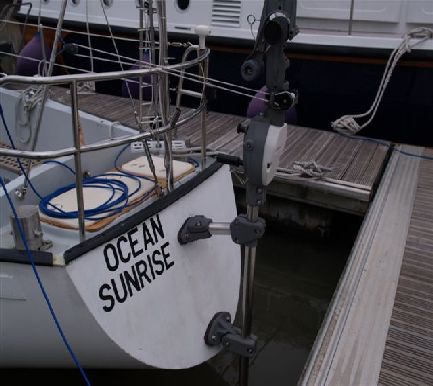
 Niagra 35
Niagra 35
“Over 11,000 miles and it worked well in all conditions on our Niagara 35. Steered better than we could in a gale that saw gusts of 50 knots.”
“It belongs in the Smithsonian!”
From: Tom Ehmann
Sent: Wednesday, July 19, 2006 8:49 AM
To: John Curry
Subject: well done
Hi John
Just a note to say that the hydrovane worked great on our trip. Over 11,000 miles and it worked well in all conditions on our Niagara 35. Steered better than we could in a gale that saw gusts of 50 knots.
We knew lots of other cruisers turning on their engines since their steering vanes couldn’t handle less than 5 knots but we just drifted along using the hydrovane – e.g. all the way through the ITCZ. It belongs in the Smithsonian!
Tom Ehmann, S/V Aurora B
Contact

